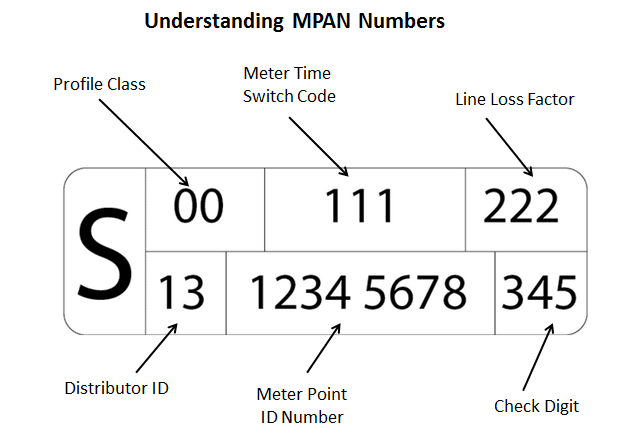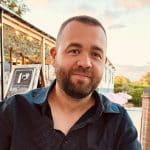What are MPAN and MPRN numbers and where can I find them?
Navigating the world of business energy can sometimes feel like deciphering a secret code, especially when you’re met with terms like MPAN and MPRN.
But fear not! These terms, while sounding technical, are crucial identifiers in the energy sector. They ensure that your business gets the right supply.
Whether you’re considering switching energy suppliers or just curious about those unique numbers on your bills, we’re here to shed light on the matter.
Let’s start by diving into one of these terms, the MPAN number, and unravel its significance for your business.

Article Contents
What is an MPAN number?
An MPAN, or Meter Point Administration Number, is the unique identity reference number for your electricity meter. Often referred to as an ‘S number’ or ‘Supply Number’, it’s a 21-digit code that typically starts with an ‘S’. This number is unique to your premises and doesn’t change even if you switch energy suppliers.
Here is a visual representation of what your MPAN number looks like on your meter or bill.

What do the numbers on an MPAN mean?
The MPAN is a structured 21-digit number, and each segment provides specific information about your electricity supply. Here’s a breakdown of what the digits represent:
| Segment Name | Description | Example |
|---|---|---|
| Profile Class | Indicates the typical electricity usage at your property. | 01 |
| Meter Time Switch Code (MTC) | Refers to whether your meter is a single rate or time of use meter. | 123 |
| Line Loss Factor (LLF) | Represents the amount of electricity lost as it’s supplied to your meter. It’s tied to the distribution network. | 456 |
| Distribution ID | Identifies the regional distribution company for your electricity supply. | 16 |
| Meter Point ID | Unique identifier for your meter within your distribution area. | 6789 0123 |
| Check Digit | Calculated from the Distributor ID and Meter Point ID numbers to verify both numbers. | 222 |
Profile Class Breakdown:
- 01 – Domestic Unrestricted Customers.
- 02 – Domestic Economy 7 Customers.
- 03 – Non-Domestic Unrestricted Customers.
- 04 – Non-Domestic Economy 7 Customers.
- 05 to 08 – Non-Domestic Maximum Demand Customers with varying Peak Load Factors.
- 00 – Peak load usage of electricity above 100 kW.
The Peak Load Factor refers to the ratio of electricity used in a given period, divided by the total possible kilowatt-hours that could have been used in the same period, at the peak kW level your business can use. It essentially indicates how your business consumes electricity.
How to find your MPAN number
Your MPAN is a pivotal identifier for your electricity supply, but it’s not directly imprinted on your electricity meter. However, there are several methods to retrieve it:
- Electricity Bill: The most straightforward approach. Your MPAN is typically displayed on your electricity bill, often located at the top left or bottom right.
- Contacting Your Regional Electricity Supplier: If your bill isn’t accessible or the MPAN isn’t evident, you can contact your regional electricity supplier. They can provide your MPAN using your account details.
- Online Platforms: Platforms like Find My Supplier can help you retrieve your MPAN by simply entering your building name or number and postcode.
For your convenience, here’s a comprehensive table of regional electricity suppliers, their ID numbers, and contact details:
| ID | Region Name | Operator | Phone Number |
|---|---|---|---|
| 10 | Eastern England | UK Power Networks | 0800 029 4285 |
| 11 | East Midlands | Western Power Distribution | 0800 096 3080 |
| 12 | London | UK Power Networks | 0800 029 4285 |
| 13 | Merseyside and Northern Wales | SP Energy Networks | 0330 10 10 444 |
| 14 | West Midlands | Western Power Distribution | 0800 096 3080 |
| 15 | North Eastern England | Northern Powergrid | 0800 011 3332 |
| 16 | North Western England | Electricity North West | 0800 048 1820 |
| 17 | Northern Scotland | Scottish & Southern Electricity Networks | 0800 048 3516 |
| 18 | Southern Scotland | SP Energy Networks | 0330 10 10 444 |
| 19 | South Eastern England | UK Power Networks | 0800 029 4285 |
| 20 | Southern England | Scottish & Southern Electricity Networks | 0800 048 3516 |
| 21 | Southern Wales | Western Power Distribution | 0800 096 3080 |
| 22 | South Western England | Western Power Distribution | 0800 096 3080 |
| 23 | Yorkshire | Northern Powergrid | 0800 011 3332 |
It’s essential to ensure you have the correct MPAN, especially during processes like supplier switches or relocations, as it’s unique to your premises.
What is an MPRN number?
An MPRN, or Meter Point Reference Number, is the distinct identity reference number designated to your gas meter. Sometimes, it’s colloquially termed as an ‘M’ number.
This code comprises between six and 10 digits. Much like the MPAN for electricity, it remains steadfastly unique to your business premises. This means that even if you decide to switch your business gas suppliers, this number remains unchanged.
The MPRN plays a pivotal role in the energy sector. It ensures that gas suppliers can accurately pinpoint your gas supply point. It’s the key to ensuring that your gas supply is correctly associated with your business, making tasks like billing, addressing issues, or even switching suppliers seamless and error-free.
How to find your MPRN number
Locating your MPRN is essential for various gas-related tasks, and fortunately, there are several straightforward methods to retrieve it:
- Gas Bill: The most direct way to find your MPRN is by checking your gas bill. It’s usually prominently displayed, often labelled as the ‘Meter Point Reference’ or simply ‘MPRN’.
- On the Gas Meter: Unlike the MPAN for electricity, the MPRN can sometimes be found directly on your gas meter. It’s worth taking a quick look, especially if you don’t have a recent bill to hand.
- Contacting Your Gas Supplier: If you’re unable to locate the MPRN on your bill or meter, don’t fret! Simply reach out to your current gas supplier, and they’ll be able to provide it using your account details.
- Online Platforms: There are online services, such as “Find My Supplier”, where you can enter your postcode and address to retrieve your MPRN. It’s a handy tool, especially if you’ve recently moved to new premises and don’t have a bill yet.
- Independent Gas Transporters (IGTs): If your gas is supplied by an IGT rather than the National Grid, your MPRN might start with a ’74’ or ’75’. In such cases, you can contact the IGT directly to get your MPRN.
Remember, the MPRN is unique to your premises, ensuring that your gas supply is correctly identified. Whether you’re addressing billing queries, reporting issues, or considering a supplier switch, having your MPRN on hand can streamline the process.
What should I do if I can't find my MPAN or MPRN numbers?
First and foremost, don’t panic. If you’re having difficulty locating your MPAN or MPRN numbers, there are several avenues to explore.
Your energy supplier is a great starting point. They keep records of both your MPAN and MPRN. A quick call with your account details at hand, and they should be able to assist you promptly.
If you’ve kept older bills, even if they’re not the most recent, give them a look. Both numbers remain consistent across bills, so any previous statement should have the information you need.
Online resources can be incredibly helpful. Platforms like “Find My Supplier” allow you to input your postcode and address to retrieve both numbers without any fuss.
Still coming up short? The Meter Number Helpline is another option. By dialling 0870 608 1524, they can guide you in obtaining your MPAN. For the MPRN, they might point you towards your gas distributor.
For those who’ve recently moved and are without bills from the previous occupant, the property’s former supplier can be a lifeline. Reach out to them, and they should provide you with both the MPAN and MPRN numbers.
Remember, these numbers, while technical sounding, play a pivotal role in managing your energy supply. Whether it’s for billing clarifications, issue reporting, or supplier switches, having them accessible is essential.
Why is it important to know your energy meter numbers?
Knowing your energy meter numbers, specifically your MPAN and MPRN, is akin to having the keys to your energy supply. These unique identifiers ensure that your energy consumption is accurately recorded, billed, and managed.
Firstly, these numbers are essential for accurate billing. Without the correct MPAN or MPRN, you could be billed based on someone else’s consumption, leading to potential overcharges or undercharges.
Secondly, if you ever decide to switch energy suppliers, these numbers are crucial. Suppliers use them to identify your energy supply points, ensuring a smooth transition without any disruptions.
Additionally, in the unfortunate event of an energy supply issue or outage, having your MPAN and MPRN on hand can expedite the resolution process. By providing these numbers, you help energy providers quickly pinpoint the problem, leading to faster solutions.
Lastly, if you’re relocating your business or moving to a new home, these numbers play a pivotal role. They help in closing accounts at your old premises and setting up new ones at your new location, ensuring a continuous energy supply.
Do MPAN and MPRN numbers change when you switch suppliers?
No, they don’t. Your MPAN and MPRN numbers are steadfastly tied to your property, not your energy supplier. Think of them as the permanent addresses for your electricity and gas supplies, respectively.
When you decide to switch energy suppliers, what changes is the company providing you with energy and potentially the tariff you’re on. However, the physical points of supply for electricity and gas at your premises remain unchanged. As a result, your MPAN for electricity and MPRN for gas stay the same.
This consistency is beneficial. It ensures a seamless transition when switching suppliers, as there’s no need for new meter installations or changes to the existing infrastructure. It also means that if you’ve noted down or memorised your MPAN and MPRN once, you won’t have to go through the process again, regardless of how many times you switch suppliers.
How do I switch business energy suppliers with Utility Saving Expert?
Switching your business energy supplier with Utility Saving Expert is a breeze.
If you’re looking to switch business gas or secure better business electricity rates, start by visiting their website. Input a few basic details about your company, and our business energy comparison tool will present you with tailored options.
Should you need further assistance or prefer a personal touch, you can call an energy expert on 01242 32 31 31. They’ll guide you through the process, ensuring you benefit from the best deals without any hassle.

Chris Richards
Chris is a personal finance specialist who founded Council Tax Advisors in 2012, assisting over 250,000 people with their Council Tax debt. Observing that many clients overpaid on utilities, he launched Utility Saving Expert in 2014, an energy price comparison site. In 2016, the platform expanded its services to include consumer and business insurance comparisons. Utility Saving Expert stands out with its commitment to social responsibility, donating 10% of net profits to fuel poverty charities, underscoring its dedication to both client value and community support.
